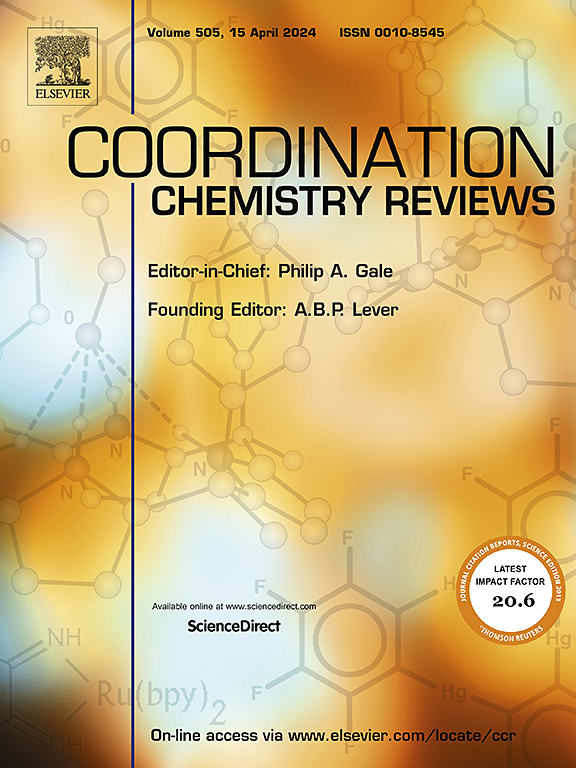Coordination and organometallic compounds of graphyne and graphdiyne: Synthesis, properties and applications
IF 23.5
1区 化学
Q1 CHEMISTRY, INORGANIC & NUCLEAR
引用次数: 0
Abstract
Graphyne (GY) and graphdiyne (GDY) are the different polymorphs of carbon with sp and sp2-hybridization, and have arisen as gifted 2D-materials for various applications in electronics, energy, and environmental sustainability. This review manuscript provides a detailed and critical examination of recent advancements in the synthesis, functionalization, and practical deployment of GY and GDY-based materials. Beginning with an overview of their unique structural and electronic features compared to other carbon materials, the discussion extends to current synthesis strategies, including bottom-up construction and doping methods, supported by computational insights into adsorption and reactivity behavior. Much of the review focuses on theoretical and computational studies, especially those involving coordination or organometallic compound-supported GY systems. The diverse application spectrum of GY materials is thoroughly explored, encompassing energy storage, gas sensing, desalination, ethanol-water separation, drug delivery, hydrogen storage, and electrocatalysis. In addition, the development and functionality of graphyne nanotubes (GYNTs) are deliberated in light of their enhanced properties and probable applications. The synthesis pathways and expanding role of GDY are also detailed, emphasizing energy systems, catalysis, water splitting, and sensing technologies. The inclusion of recent patent literature further illustrates the translational potential of these materials in industrial and commercial applications. Finally, the review addresses current material quality, scalability, and reproducibility limitations, while offering future perspectives for advancing the design and utilization of GY and GDY in real-world applications. This work aims to serve as a foundational resource for researchers exploring the multifaceted roles of 2D nanomaterials in science and technology.
石墨炔和石墨炔的配位和有机金属化合物:合成、性质和应用
石墨炔(GY)和石墨炔(GDY)是具有sp和sp -杂化的碳的不同多态性,并且已经成为电子,能源和环境可持续性的各种应用的天赋2d材料。这篇综述手稿提供了一个详细的和关键的审查,在合成,功能化和实际部署的GY和gdd基材料的最新进展。从概述其独特的结构和电子特征开始,与其他碳材料相比,讨论扩展到当前的合成策略,包括自下而上的构建和掺杂方法,由对吸附和反应性行为的计算见解支持。大部分综述集中于理论和计算研究,特别是那些涉及配位或有机金属化合物支持的GY系统的研究。深入探讨了GY材料的多种应用范围,包括储能,气体传感,海水淡化,乙醇-水分离,药物输送,储氢和电催化。此外,根据石墨炔纳米管的增强性能和可能的应用前景,对石墨炔纳米管的发展和功能进行了讨论。详细介绍了GDY的合成途径和扩展作用,重点介绍了能量系统、催化、水裂解和传感技术。最近的专利文献进一步说明了这些材料在工业和商业应用中的转化潜力。最后,该综述解决了当前材料质量、可扩展性和可重复性的限制,同时为在实际应用中推进GY和GDY的设计和利用提供了未来的展望。这项工作旨在为研究人员探索二维纳米材料在科学技术中的多方面作用提供基础资源。
本文章由计算机程序翻译,如有差异,请以英文原文为准。
求助全文
约1分钟内获得全文
求助全文
来源期刊

Coordination Chemistry Reviews
化学-无机化学与核化学
CiteScore
34.30
自引率
5.30%
发文量
457
审稿时长
54 days
期刊介绍:
Coordination Chemistry Reviews offers rapid publication of review articles on current and significant topics in coordination chemistry, encompassing organometallic, supramolecular, theoretical, and bioinorganic chemistry. It also covers catalysis, materials chemistry, and metal-organic frameworks from a coordination chemistry perspective. Reviews summarize recent developments or discuss specific techniques, welcoming contributions from both established and emerging researchers.
The journal releases special issues on timely subjects, including those featuring contributions from specific regions or conferences. Occasional full-length book articles are also featured. Additionally, special volumes cover annual reviews of main group chemistry, transition metal group chemistry, and organometallic chemistry. These comprehensive reviews are vital resources for those engaged in coordination chemistry, further establishing Coordination Chemistry Reviews as a hub for insightful surveys in inorganic and physical inorganic chemistry.
 求助内容:
求助内容: 应助结果提醒方式:
应助结果提醒方式:


